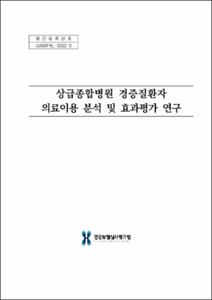상급종합병원 경증질환자 의료이용 분석 및 효과평가 연구
- Type
- Research report
- Issued Date
- 2022-01
- Keyword
- 경증질환; 정책효과; 의료전달체계; Mild Diseases Patients; Healthcare Delivery System; Healthcare Utilization; Interrupted Time Series; Health Insurance Review & Assessmet
- Abstract
- Background: The purpose of this study is to analyze the healthcare utilization and policy effects for mild diseases patients in tertiary hospital. In 2011, The Ministry of Health and Welfare come up with the plan for redefining role of medical institutions for the establishment of healthcare delivery systems. The government have instituted several policy such as increase in coinsurance rate for outpatients at tertiary hospital, differential coinsurance policy on prescription drug coverage in an effort to improve patient’s concentrations problem on tertiary hospital.
Methods: This study used a National Health Insurance Claims Data, collected by Health Insurance Review and Assessment(HIRA) from 2008 to 2020, and we analyzed healthcare utilization for mild diseases patients over a long period. We classified mild diseases characteristics as chronic and non-chronic diseases, and analyzed trend of healthcare utilization depending on its characteristics. The short-term effects is identified by comparing for 1 year before and after intervention. And we analyze the long-term effects using Interrupted Time Series analysis.
Results: In the chronic and non-chronic mild diseases, the number of visits and portions of mild diseases outpatients who visited tertiary hospital decreased by before and after interventions. However, hospitalizations and emergency room visits have increased or remained unchanged since the policies. We showed that differential coinsurance policy on prescription drug coverage among policies aimed at improving healthcare systems was an immediate drop in the portions of mild diseases outpatients. In addition to the policy to control demand, the second tertiary hospitals designation system, which controled supply, showed a long-term effects of continuously decreasing the proportions of outpatients with mild diseases.
Discussion: Afrer differential coinsurance policy on prescription drug coverage, the healthcare utilization of outpatients with mild diseases have increased in clinics, but similarly in hospitals. Therefore, starting with primary care, it is necessary to improve the healthcare delivery systems so that referrals requests can be made step by step to upper medical institutions. We analyzed the healthcare utilization of outpatients with mild diseases using Interrupted Time Series. The result showed that the healthcare utilization of outpatients with mild diseases and multimorbidity have decreased even more. We consider that the government should build the management of chronic diseases for outpatients with chronic mild diseases and multimorbidity to improve policy effects.
- Publisher
- 건강보험심사평가원
- Alternative Title
- Analysis of the healthcare utilization for mild diseases patients and study on policy effects in tertiary hospital
- Table Of Contents
- 요 약 ⅰ
제1장 서 론 ···································································································· 1
1. 연구 배경 ······································································································ 1
2. 연구 목적 ······································································································ 4
3. 주요 연구 내용 ···························································································· 4
제2장 이론적 고찰 ························································································· 7
1. 제도 고찰 ······································································································ 7
가. 의료전달체계 재정립 관련 정책 ························································· 7
나. 상급종합병원 외래 본인부담률 인상 ·················································· 8
다. 경증질환 약제비 본인부담률 차등제 ················································ 10
라. 상급종합병원 지정 기준 ···································································· 13
2. 선행연구 검토 ···························································································· 15
가. 상급종합병원 외래 본인부담률 인상 ················································ 15
나. 경증질환 약제비 본인부담률 차등제 ················································ 17
다. 상급종합병원 지정 기준 ···································································· 19
라. 본인부담과 의료이용 ·········································································· 19
3. 시사점 ········································································································· 20
제3장 의료이용 현황 및 효과 분석 ···························································· 21
1. 분석 개요 ···································································································· 21
가. 분석 틀 ································································································ 21
나. 분석 대상 및 정의 ············································································· 22
2. 경증질환자 의료이용 현황 ······································································· 32
가. 연도별 경증질환자 의료이용 현황 ··················································· 32
나. 연도별 만성 경증질환자 의료이용 현황 ·········································· 35
3. 정책효과 분석 ···························································································· 38
가. 환자 수 비율 및 환자당 방문횟수 분석 ·········································· 38
나. 신규 경증질환자 분석 ········································································ 51
다. 이용경로 분석 ····················································································· 52
라. 입원율 및 응급실 방문율 분석 ························································· 56
제4장 정책의 장기효과 평가 ······································································· 59
1. 분석 개요 ···································································································· 59
가. 단절적 시계열 분석(Interrupted Time Series Analysis: ITS) 59
나. 자료 구축 ····························································································· 60
2. 분석 방법 ···································································································· 61
가. 모형 설정 ····························································································· 61
나. 변수 설명 ····························································································· 62
3. 분석 결과 ···································································································· 63
가. 상급종합병원 경증질환 정책 효과 ··················································· 63
나. 상급종합병원 만성 및 만성 외 경증질환 정책 효과 ····················· 66
다. 상급종합병원 복합만성질환자 경증질환 정책 효과 ······················· 72
라. 상급종합병원 중증도별 경증질환 정책 효과 ·································· 78
제5장 논의 및 결론 ····················································································· 85
1. 상급종합병원 경증질환자 의료이용 및 정책효과 분석 결과 ··············· 85
가. 의료이용 현황 및 정책효과 분석 ····················································· 85
나. 정책의 장기효과 평가: 시계열 분석 ················································ 87
2. 제언 ············································································································· 87
3. 제한점 ········································································································· 89
참고문헌 ········································································································ 91
ABSTRACT ·································································································· 95
부 록 ··········································································································· 97
- Publisher
- 건강보험심사평가원
- Location
- KOR
- Citation
- 김상현 et al. (202201). 상급종합병원 경증질환자 의료이용 분석 및 효과평가 연구.
- 파일 목록
-
-
Download
 상급종합병원 경증질환자 의료이용 분석 및 효과평가 연구.pdf
기타 데이터 / 2.17 MB / Adobe PDF
상급종합병원 경증질환자 의료이용 분석 및 효과평가 연구.pdf
기타 데이터 / 2.17 MB / Adobe PDF
-
Items in Repository are protected by copyright, with all rights reserved, unless otherwise indicated.